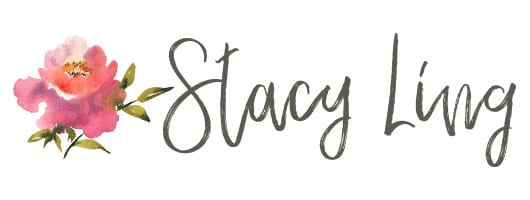Ready to grow your own beautiful blooms? Flower gardening for beginners doesn’t have to be complicated! This easy start guide will show you how to start your flower garden today.
Welcome to the world of beginner flower gardening, where beautiful blooms and lush greenery come together to create a breathtaking symphony of colors and fragrances. Whether you’re a novice with a newfound passion for plants or simply looking to add a touch of natural beauty to your outdoor space, this post is your gateway to the enchanting realm of flower gardening for beginners.
Today, I’m sharing lots of essential steps, tips, and inspiration you need to embark on your journey as a budding gardener so you can transform your backyard, balcony, or windowsill into a flourishing oasis of blossoms and joy.
We’ve got a lot of ground to cover! Are you ready? Your green thumb starts…Now!
(Posts on stacyling.com may contain affiliate links. Click HERE for full disclosure.)
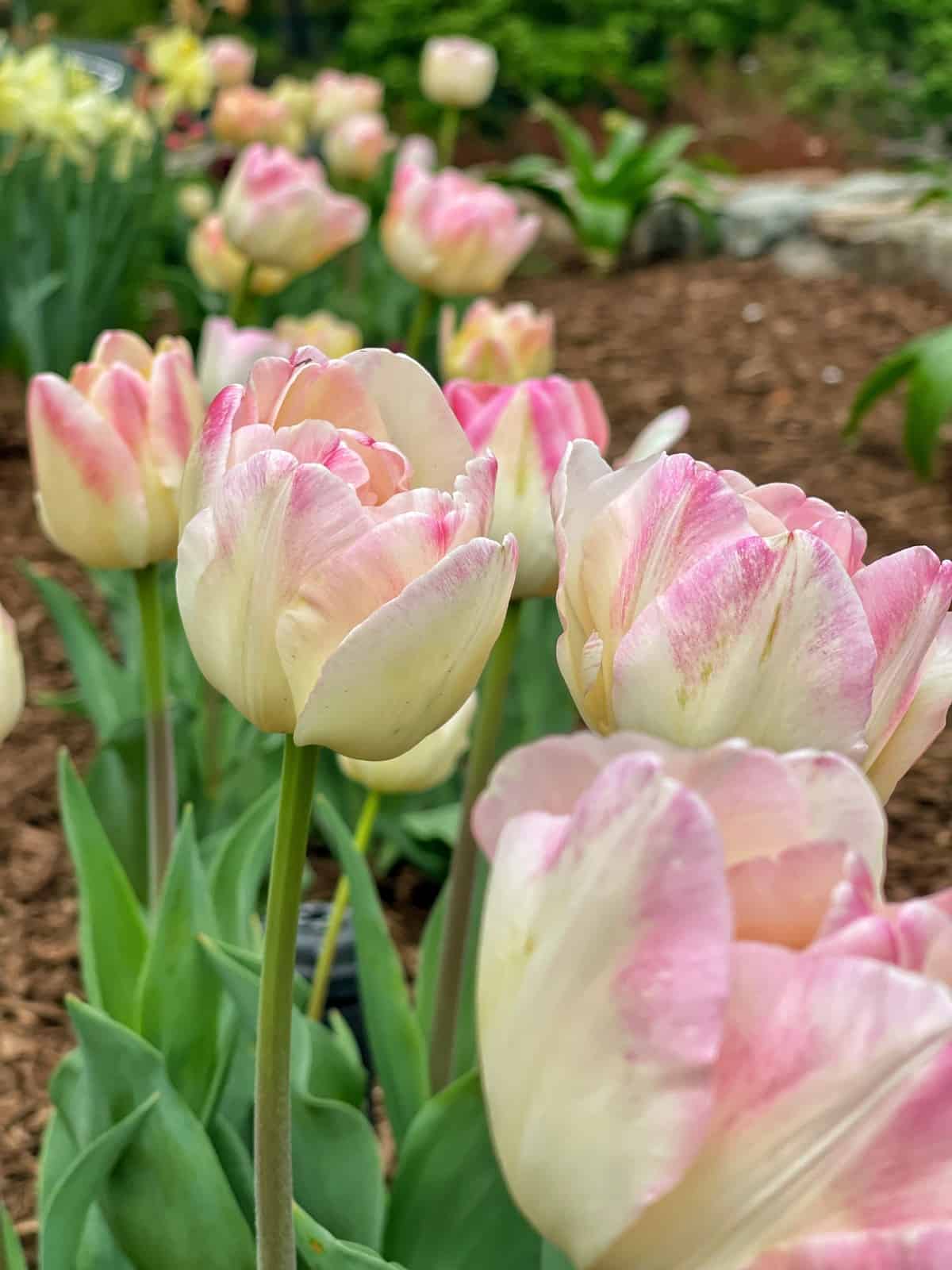
Flower Gardening for Beginners: First Steps
Understanding Your Hardiness Zone
Your hardiness zone determines which plants are most likely to thrive in your location. This is essential for knowing what to plant and when, as it impacts whether a plant will be perennial (surviving year-round) or annual (lasting one season). Not sure what your hardiness zone is? Click here to find out. As a reference, my garden is located in zone 6b in New Jersey.

Flower Gardening for Beginners: Essential Garden Tools and Supplies
Before you dig in, make sure you have the right tools for the job! Here’s a basic list for beginner gardeners:
- garden shovel
- garden fork
- spade shovel
- hand trowel
- garden gloves
- pruners
- wheelbarrow
- sunscreen (always)
- sunhat
For more detailed information on these tools and my recommended supplies, read this post here on my favorite beginner garden tools.

Determining Your Garden Size
Before planning your garden, decide how big (or small) you want it to be. There’s no right or wrong answer! For beginners, starting small is often easier, and you can always expand later. Consider using a small lawn area, a few raised beds, or even pots and window boxes. Knowing your space will also help determine your garden’s ideal location.
Choosing the Perfect Spot for Your Flower Garden
Several factors are key to choosing your garden’s location:
- Water Access: Is there a nearby hose or irrigation system? Avoid areas where watering will be difficult.
- Drainage: Does the spot drain well after rain? Soggy soil isn’t ideal for most flowers.
- Visibility: While not essential for plant growth, choose a spot you’ll enjoy seeing regularly. A garden you can admire from your windows or patio will bring you more joy.

Assessing Sunlight and Shade For Your Flower Garden
Before planting, research your chosen flowers’ light needs. Not all thrive in full sun, and some prefer shade. To determine your garden’s light conditions:
- Observe: Track sunlight in your garden hourly for a full day.
- Classify:
- Full sun: 6-8 hours of direct sunlight.
- Partial sun/shade: 4-6 hours of direct sunlight.
- Shade: Less than 4 hours of direct sunlight.
Always check plant tags to ensure your choices match your garden’s conditions.
When to Plant: Timing Your Flower Garden for Success
One of the first questions new gardeners often ask is, “When should I actually start planting?” The answer, like many things in gardening, isn’t one-size-fits-all and depends on a few key factors, primarily your local climate and the types of flowers you want to grow. However, understanding these principles will set you up for success.
Understanding Your Growing Season:
The most crucial element is knowing your region’s last expected frost date in the spring and the first expected frost date in the fall. These dates act as bookends for your active growing season. You can usually find this information through your local agricultural extension office, nearby nurseries, or online gardening resources specific to your zip code.
General Guidelines Based on Flower Type:
- Cool-Season Annuals: These are your hardy heroes that thrive in cooler temperatures and can often tolerate light frosts. Think pansies, violas, snapdragons, and sweet peas. You can typically plant these in early spring, a few weeks before your last expected frost, or even in late summer/early fall for a fall and early winter bloom in milder climates.
- Warm-Season Annuals: These sun-loving beauties, like zinnias, petunias, marigolds, and cosmos, need warmer soil and air temperatures to flourish. It’s best to wait until all danger of frost has passed in the spring and the soil has warmed up. Planting too early can stunt their growth or even kill them.
- Perennials: These plants come back year after year, and the ideal planting time depends on the specific variety. Generally, spring or early fall are good times to plant perennials. Spring planting allows them to establish their root systems before the heat of summer, while fall planting gives them a chance to settle in before winter dormancy. Avoid planting perennials during the hottest part of the summer.
- Bulbs: Spring-blooming bulbs like tulips, daffodils, and hyacinths are typically planted in the fall, before the ground freezes. Fall planting allows them to go through the necessary chilling period to bloom beautifully in the spring. Summer-blooming bulbs like gladiolus and dahlias are usually planted in the spring after the danger of frost has passed.
Key Considerations for Timing
- Local Microclimates: Even within the same region, variations in sunlight, wind exposure, and elevation can create microclimates that affect planting times. Observe your local conditions.
- Soil Temperature: For warm-season annuals and some perennials, soil temperature is just as important as air temperature. Cold soil can shock young plants.
- First and Last Frost Dates: These are estimates, and weather can be unpredictable. Keep an eye on the forecast and be prepared to protect young plants if unexpected frost threatens.
- Planting Method: Starting seeds indoors gives you a head start on the growing season, especially for warm-season annuals in cooler climates. You can sow seeds several weeks before your last frost date and transplant seedlings outdoors once the weather is suitable. Direct sowing seeds outdoors is best done when the soil has warmed up.
Pro-Tip: If you are just starting out, skip seed starting and shop your local nursery for plants so you can enjoy immediate satisfaction and learn how things grow.

Four Simple Ways to Start Your First Garden
Whether expanding on existing gardens or starting from scratch, consider these four beginner-friendly methods:
- Traditional Ground Gardening: This classic approach involves digging and removing existing sod. It’s labor-intensive but provides a quick start.
- Lasagna Gardening: A beginner-friendly, “no-dig” method. Layer newspaper or cardboard, then brown and green waste (leaves, grass clippings), and finally soak the layers. This creates rich soil over several weeks, perfect for planting.
- Raised Bed Gardening: Ideal for limited space or those who prefer elevated gardening, raised beds offer better drainage and warmer soil. DIY options allow for customization in size and design. If growing edibles, choose untreated wood like cedar to avoid harmful chemicals.
- Container Gardening: Perfect for small spaces, beginners, or those seeking flexibility. Almost anything can be grown in containers, even vegetables.


Preparing Your Soil: The Foundation of a Thriving Garden
After choosing your garden’s location and method, it’s time to focus on the most crucial step: soil preparation. Good soil is the foundation of a healthy garden.
Before planting, test your soil to understand its needs. This will help you determine the right amendments to ensure your plants thrive. Soil test kits are available online, or you can seek help from your local cooperative extension, master gardener helpline, or garden nursery.
Remember, amend your soil annually to maintain its fertility and ensure your plants have the nutrients they need to flourish.

Enriching Your Soil with Compost
Compost is one of the best ways to improve your soil, and making your own is easy and budget-friendly. (Click on the link to read my article and see how easy it is to make yourself). If you’re not ready to make your own, bagged compost is available at garden centers.
Using Leaf Mold to Boost Your Garden
Leaf mold, made from decomposed leaves, is an excellent addition to your garden soil. It improves soil structure, water retention, and nutrient content, leading to healthier plants and a more eco-friendly garden. (Click on the link to read my article about how easy it is to make leaf mold yourself).
Mulching: Protecting and Nourishing
After planting, add mulch to your beds to suppress weeds and improve soil quality as it decomposes. Avoid putting it directly on top of your plants and leave a little space around their base. As an aside, I personally rely on good soil quality and don’t use additional fertilizers for perennials, trees, or shrubs in my gardens.
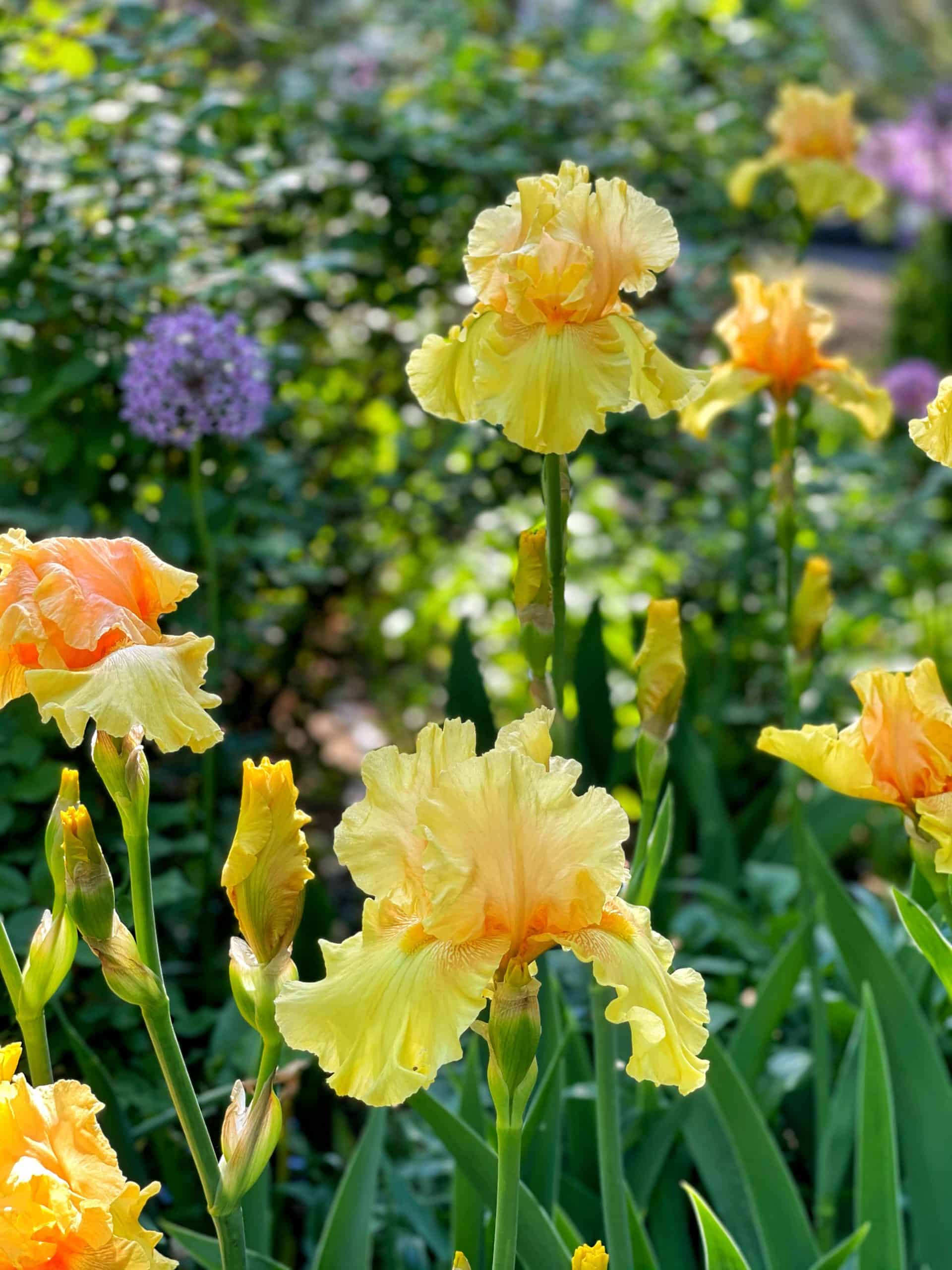
Planting Flowers 101: A Simple Step-by-Step Guide
Planting flowers is easier than you think! Here’s your step-by-step guide:
Supplies
- Hand Trowel or Garden Shovel
- Garden Soil (for the ground) or Potting Soil for Containers
- Plants of your Choice
Steps for Planting Flowers
- Dig: Create a hole twice the size of the plant’s root ball.
- Prepare the Plant: Gently remove the plant from its container. If rootbound, loosen the roots with your fingers or by cutting them.
- Plant: Add some soil to the hole, place the plant inside, and fill the remaining space with soil. Mix in some existing soil while backfilling.
- Mulch: Add a layer of mulch to help retain moisture and suppress weeds.
- Water: Give your new plant a good drink.
If working with a container, follow these container gardening tips for planting.

Flower Gardening for Beginners: Basic Maintenance Tips
Watering Your Flower Garden: Tips for Success
As a general rule, water your flower garden when the top two inches of soil feel dry. Aim to water at the base of plants earlier in the day to allow excess moisture to evaporate and reduce the risk of disease.
The ideal watering frequency and amount depend on various factors, including rainfall, location, climate, and soil preparation. Planning your garden layout with water needs in mind can make watering easier.
Group plants with similar water requirements together, placing those that need more water closer to your water source and drought-tolerant ones further away. Remember, even drought-tolerant plants need regular watering until their roots are established.
Gardening 101 Tip: If you are not sure how well an area drains, dig a hole that is 1 foot by 1 foot, fill it with water, and see how quickly it drains. If it drains in under 30 minutes, it is a great spot for plants that need dry or well-draining soil.

Fertilizing Your Flower Garden: Less is Often More
While some plants benefit from supplemental nutrients, over-fertilizing is a common mistake. Focus on building healthy soil as a foundation. In my experience, perennials, shrubs, and trees thrive without additional fertilizer. However, I do recommend fertilizing roses, container gardens, houseplants, annuals, and vegetables.
- For my flowers, houseplants, and other annuals, I use this slow-release fertilizer because it lasts for a few months and is set and forget.
- To feed my roses, I use this organic rose fertilizer that helps produce an abundance of blooms.
- And for my vegetables and herbs, I use this organic fertilizer.

Flower Gardening for Beginners: Pruning and Deadheading Flowers
Pruning and deadheading are essential for keeping your garden tidy and promoting healthy growth. However, not all plants require the same care.
For woody plants like hydrangeas and shrubs, specific pruning guidelines should be followed. You can learn more about it in this post.
For perennials, annuals, and roses, deadheading flowers is super simple:
- Using garden snips, pruners, or your fingers, cut the flower stem just below the spent bloom, above the first set of healthy leaves.
- Check for hidden buds before removing large sections to avoid cutting off future blooms.
Remember, not all plants require deadheading. Learn about your specific plants’ needs for optimal care.

Dividing Perennials: Promote Health and Share the Bounty
Dividing perennials every few years offers several benefits:
- Improved plant health and vigor
- Maintains desired plant size
- Prevents overcrowding
- Creates new plants without spending money
- Keeps plants under control
How to Divide Perennials
- Gather Tools: Depending on plant size, you’ll need a hand trowel or spade shovel.
- Identify Division Lines: Observe the plant to find natural sections for separation.
- Dig Carefully: Start at the outer edge and slide your tool beneath the plant, minimizing root damage. Some plants lift out easily, while others need more digging around the perimeter.
- Transplant Quickly: Replant the divisions as soon as possible.
Don’t worry about causing minor damage; perennials are resilient and will bounce back. Read this post to learn more about how to divide perennials.
Fun Fact: Did you know that hydrangeas can be divided too? Yes!

Flower Gardening for Beginners: Protecting Your Blooms
Regularly inspect your flower to catch pest and disease problems early. The sooner you address an issue, the better chance you have of saving your plants. Here’s my approach to troubleshooting garden problems:
- Daily Inspections: Walk through your garden every day, looking closely at leaves, stems, and flowers for signs of damage, discoloration, or pests.
- Quick Action: If you spot a problem, take action immediately. Don’t wait, as issues can worsen quickly.
For specific guidance on identifying and treating common pests and diseases, click here.

Protecting Your Flower Garden from Deer
If deer frequent your area, protecting vulnerable plants is essential. While some plants are less appealing to deer, they can eat anything if hungry enough. Repellents are an effective deterrent. I’ve personally had success with both topical repellents, which emit a scent, and systemic ones, which are absorbed by the plant.
For a complete guide on protecting your garden from deer, including a list of deer-resistant plants, click here.

Attracting Beneficial Insects: Nature’s Pest Control
Beneficial insects like ladybugs and praying mantises are nature’s pest control. In my own garden, ladybugs helped me overcome a severe scale infestation that organic sprays couldn’t eliminate. I share a whole post on how I added ladybugs to my garden here.
You can attract these helpful insects by planting flowers that provide nectar and pollen, avoiding broad-spectrum pesticides, and providing shelter like insect houses or rock piles.

Managing Japanese Beetles: A Long-Term Solution
Japanese beetles can wreak havoc on your garden, defoliating plants in the summer. While manually removing them is an option, it can be time-consuming. Pheromone traps can attract more beetles than they catch, making the problem worse. For a more effective, long-term solution:
- Overseed your lawn with tall fescue: Japanese beetles prefer to lay eggs in sunny areas with short grass. Tall fescue creates shade and deters them.
- Apply milky spore: This naturally occurring bacteria targets Japanese beetle grubs in the soil, reducing future populations. I use this milky spore on my lawn with this applicator.
This approach requires patience, but it’s a sustainable and effective way to manage Japanese beetles in the long run.
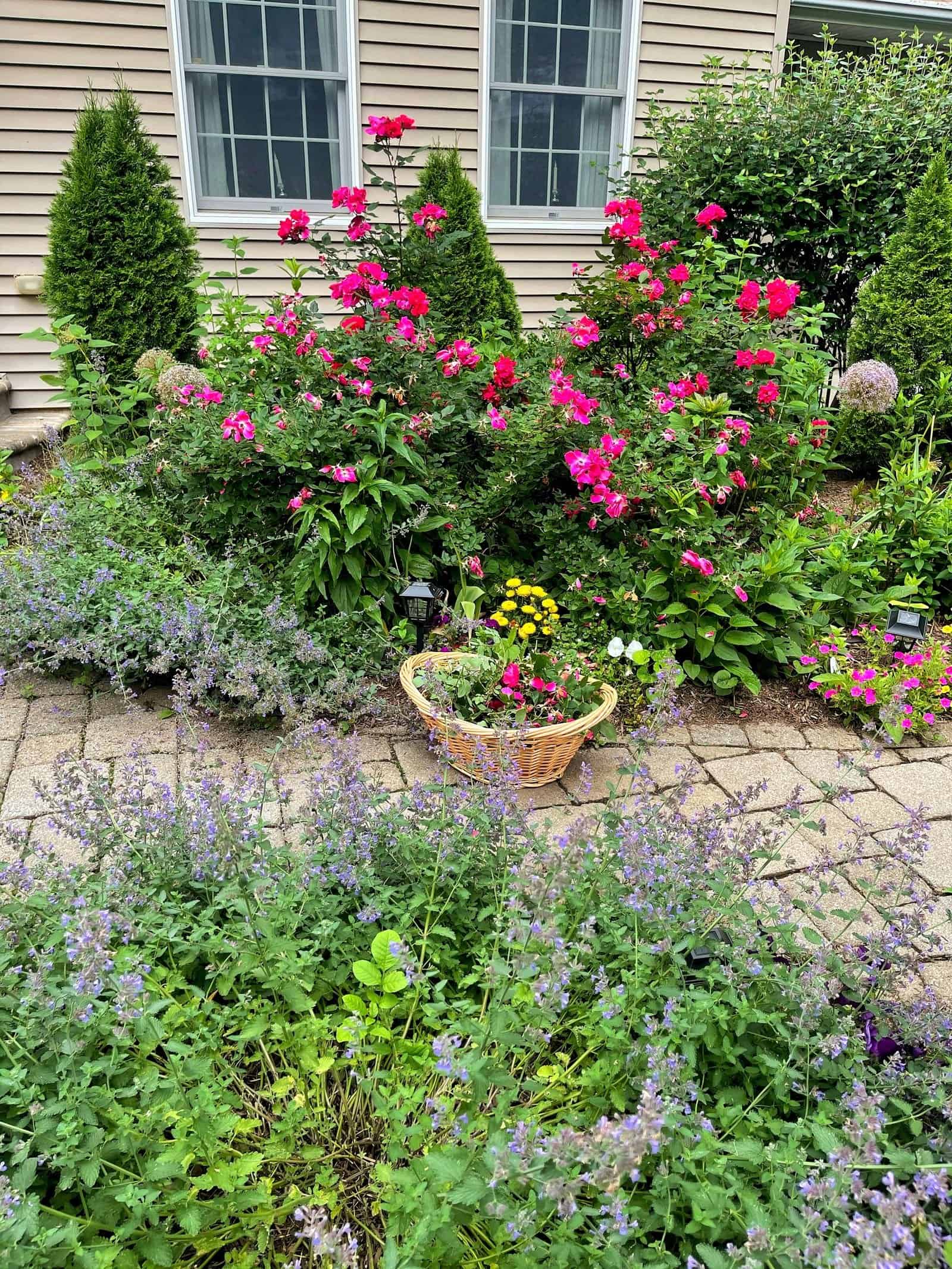
Companion Planting: Natural Pest Control
Companion planting is a simple yet effective way to improve your garden’s health and productivity. By strategically pairing plants, you can harness their natural abilities to benefit each other.
Some plants act as natural pest repellents, protecting their neighbors. Others improve soil health by adding nutrients or provide physical support. This technique not only helps with pest and disease management but also maximizes space, which is especially helpful in smaller gardens.
For beginners, easy pairings like calendula and borage with dahlias and zinnias can be a great starting point.

How to Start Your First Flower Garden
Now that we understand flower gardening for beginner basics, let’s get you started on first bed! Let’s review the crucial steps to take before starting your first flower garden.
Here are some flower gardening tips to help you begin:
- Choose the right location based on what you want to grow.
- Determine what type of garden you want to grow.
- Test and prepare the soil. Remove weeds, rocks, and debris from the planting area. Loosen the soil with a shovel or a tiller, and add organic matter such as compost or aged manure to improve soil fertility.
- Select plants that are suitable for your climate, soil type, and available sunlight. For beginners, it’s best to start with easy flowers to grow that require less maintenance.
- Follow the planting instructions on the seed packet or plant tag.
- Most plants require regular watering, especially during dry periods. Water the base of plants deeply and avoid overwatering. Check the moisture level of the soil regularly by sticking your finger about an inch into the soil. If it feels dry at that depth, it’s time to water.
- Add a layer of mulch around plants to help conserve moisture, suppress weeds, and regulate soil temperature.
- Maintain the garden all season long by regularly removing weeds, dead leaves, and spent flowers to keep the garden tidy and prevent diseases.
- Fertilize the flowering plants as needed but follow the recommended application rates.
- Watch for pests and diseases, and address them promptly.
Learn from the experience and don’t get discouraged. Gardening is a continuous learning process. Observe how your plants grow and adapt to the environment, and learn from any mistakes or successes.
Experiment with different plants, techniques, and designs to find what works best for you.
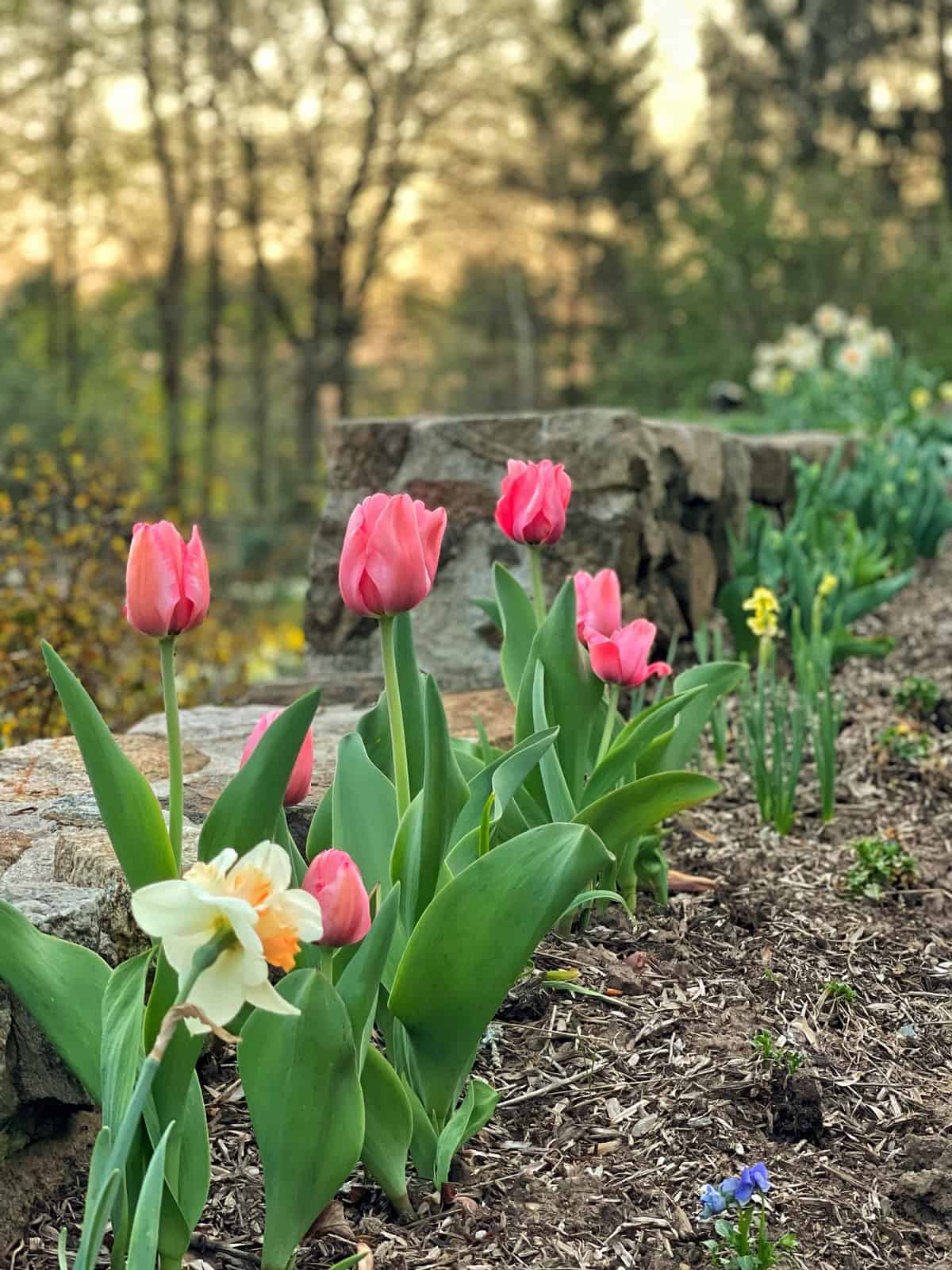
Easy Flowers for First-Time Gardeners
Now that you know the basic steps to flower gardening for beginners, let’s dive into the best types of flowers for your new garden.
Choose Native Plants: Best Flowers for Beginners
For starters, it’s a great idea to grow native plants because they are well-adapted to your locality and grow with ease. Check with your local cooperative extension, master gardeners, or local nursery to learn what’s native in your area. This is another reason why knowing your hardiness zone is so important!
Easy Flowers for Beginner Gardeners
If you are just starting out with growing blooms, there are a few easy flowering plants you should start with.
Flower Gardening for Beginners Tip: Be sure to check that these plants align with your hardiness zone before planting.
Here are some easy flowers to grow.
- Pansies
- Celosia
- Hellebores
- Hostas
- Rudbeckia
- Coneflowers
- Bearded Iris
- Zinnias
- Hydrangeas
- Peonies
- Marigolds
- Petunias
- Blazing Star
- and so many more
But by working with the easiest flowers to grow, you’ll find greater success from the outset of learning how to garden.

Choosing Between Perennials and Annuals: A Beginner’s Guide
Understanding the difference between perennials and annuals is key for a flower garden that blooms all season long.
- Perennials: These plants return year after year, like sedum, coneflowers, and yarrow.
- Annuals: These complete their life cycle in one growing season and need to be replanted each spring.
Which is better? A mix of both! Perennials provide structure and returning beauty, while annuals offer flexibility and a longer bloom season. Together, they create a diverse and vibrant garden that attracts beneficial pollinators.
To learn more about using perennials and annuals effectively in your garden, click here.

Designing Your First Flower Garden: Tips for a Beautiful Bloom
When starting your first flower garden, it’s easy to get overwhelmed with possibilities. Planning your layout is key to creating a beautiful and thriving space.
Here are some aspects to consider when designing your garden:
- Color Scheme: Decide on a cohesive look with a few select colors or embrace a wildflower vibe with a variety of hues.
- Plant Height: Be mindful of how tall your flowers will grow, placing shorter ones in front to ensure visibility.
- Bloom Time: Choose plants with varying bloom times to ensure your garden is colorful throughout the season.
- Companion Planting: Utilize companion planting for natural pest control, pollination support, soil improvement, and plant protection.
For inspiration and more in-depth information on designing your dream garden, click here. And remember, gardening is a journey. Start small, learn as you go, and most importantly, have fun!
Designing an Everblooming Garden: Tips for Year-Round Color
To maximize my garden’s potential, I immersed myself in garden resources, from books and magazines to nursery visits. The key to year-round color is creating a layered garden, with plants strategically chosen for their varied bloom times. By combining early, mid-season, and late bloomers, you can ensure a continuous display of color and interest throughout the growing season.
Read this post if you want to grow a colorful flower garden that blooms from early spring through fall too.
Exploring Unique Garden Types for Beginners
Whether you’re brand new to gardening or you’ve been growing flowers at home for some time, it can be fun to plant different types of gardens. Here are some of my favorites that are very beginner-friendly.
Cottage Garden Design Ideas
And if you love the look of a cottage garden like I do? I got you. Characterized by a charming, informal design and a mix of a variety of plants, a cottage garden includes flowers, herbs, vegetables, and fruit trees.
Cottage gardens are often associated with the English countryside and evoke a sense of rustic, old-fashioned beauty. A key feature of a cottage garden is that it is not highly manicured or formal. Instead, it has a natural, relaxed look with plants growing in a seemingly haphazard manner.
So it is imperfectly perfect.

This creates a sense of abundance and abundance, with a mix of colors and textures that are pleasing to the eye. From beautiful flowers to pretty garden decor, here are 5 easy ways to grow a cottage garden. And check out these posts for more cottage garden design inspiration.
- Easy-care cottage garden ideas
- Easy flower garden ideas for the porch
- Click here to see how my cottage garden grew in 2021 at my former home
- Click here to see how my garden flowers grew in 2020 at my former home

Creating a Pollinator Garden for Beginners
Do you want to grow a garden that attracts pollinators like hummingbirds and butterflies? They are so fun to watch around the gardens throughout the growing season and super easy to attract too. Luckily, there are several flowers that attract both!

Butterfly Gardening 101: Essential Tips for Attracting Butterflies
Every butterfly garden has bright, bold, and beautiful nectar-loving plants that feed both butterflies and caterpillars. So it’s important to plant both host and nectar plants to attract butterflies to your garden. Click here to learn more about how to design a butterfly garden. Here are 10 of my favorite easy-care and gorgeous flowers that attract butterflies.
Hummingbird Gardening 101: How to Attract and Support Hummingbirds
Gardening for hummingbirds is similar but slightly different. Plant a variety of flowers and shrubs in varying heights to provide shade, shelter, food, and water and you’ll see hummingbirds visit your garden often. Click here to learn more about how to design a hummingbird garden. And click here for 9 easy-care blooms that attract hummingbirds.

Cut Flower Gardening for Beginners: A Starter Guide
If you enjoy a fresh bouquet of flowers indoors, I can’t tell you how rewarding a cut flower garden is. I used to be the kind of gardener who only wanted to enjoy her flowers outdoors. But now?
I’m hooked on growing flowers to harvest because you can enjoy them both in the garden and inside the home. Cut flower gardening is a little more work, but it is really fun to do and if you are interested in learning more about it, check out this post to learn how to create one.

My Favorite Beginner-Friendly Plants
Hydrangeas: A Beginner’s Guide
One of the most popular plants that new gardeners enjoy is hydrangeas. And what’s not to love? They are easy to care for, there are lots of different varieties, and the flowers are beautiful. Hydrangeas make great cut flowers and dry well for wreaths and other indoor decor. There is so much to say about them so I’ve shared tips in several different posts that I’ll list below.
- The Complete Guide to Hydrangea Care and Their Flowers
- The Basics of Hydrangea Care
- Growing Hydrangeas in Pots
- How to Dry a Hydrangea the Easy Way
- How to Divide Hydrangeas
- 7 Easy Steps to Propagating Hydrangeas
- Why Aren’t My Hydrangeas Blooming?
- Why Aren’t My Hydrangeas Blooming – Update?
- Are Hydrangeas Deer Resistant?
- How to Make a Hydrangea Wreath
- How to Prune Hydrangeas


Zinnias for Beginners: Easy Steps to Vibrant Flower Gardens
Zinnias are another popular, easy-care flower for beginners. They are tall, colorful and really simple to grow and maintain. Here are some of my resources for growing zinnias in your garden:
Other Easy Beginner Flowers to Try

Flower Gardening for Beginners: Final Thoughts
Embarking on your flower gardening journey is like starting any new adventure – it might seem a little daunting at first, but the rewards are immeasurable. Remember that every experienced gardener started exactly where you are now, learning as they went, celebrating small victories, and occasionally learning from a setback or two.
The most important thing is to start. Don’t get bogged down in the fear of perfection or the overwhelming amount of information out there. Choose a few flowers that excite you, find a sunny spot, and get your hands in the soil. Feel the connection to nature as you nurture these tiny seeds or young plants, and witness the magic unfold as they grow and bloom.
Be patient with yourself and your garden. Not every seed will sprout, and not every bloom will be flawless. That’s the beauty of nature – it’s unpredictable and ever-evolving. Embrace the learning process, observe your plants closely, and don’t be afraid to experiment.
As you watch your flower garden flourish, you’ll discover more than just beautiful blooms. You’ll find a sense of accomplishment, a connection to the natural world, and perhaps even a new way to de-stress and find joy in the simple act of creation.
So, take those first steps with confidence. Dig in, get your hands dirty, and allow the beauty of flowers to enrich your life. Happy gardening, and may your garden be filled with color, fragrance, and endless delight!
Are you new to gardening or have any tips you’d like to share? Let’s chat more about it in the comments below.
Thanks for dropping by the blog today.
